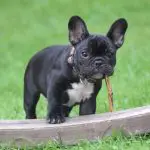Canine bloat defense
Canine bloat, sometimes called Gastric Torsion, is a deadly condition commonly seen in deep chested dogs like Dobermans, or German Shepherds. The general situation is that the dogs stomach fills with gas and twists upon itself, effectively trapping the gas and pinching veins. This lowers blood pressure significantly causing internal organs suffer as a result. The dogs oftentimes die a slow, painful death. Emergency surgery has only a success rate of around 2%.
Some believe that canine bloat is caused when dogs eat too fast and swallow air. This is partially true, but is not the real cause.
There is evidence to suggest that gastric torsion is caused by the accumulation of gases in the stomach from chemical reactions during the digestion process rather than the swallowing of air. There are two simple options owners can choose to greatly decrease the risk of bloat.
We need to split our dogs daily feeding into smaller meals, or make an attempt to slow down their eating so that their bodies have time to signal that they are full. Many pet owners feed their dogs one large meal at some point during the day, and it is oftentimes devoured very quickly. The problem with feeding one large meal is that adult dogs are much more hungry than they would be if they were fed two smaller meals a day. As a result, they eat much quicker.
They eat so quickly that their bodies do not release the necessary hormones that tell them they are full in a timely manner. The consequence is that the stomach is overloaded, and there is not much room for gases in the stomach to expand. This increases the risk of gastric torsion considerably.
If smaller meals are offered throughout the day, then there will be more room in the stomach for the gases to expand, and the body will be much better equipped to regulate itself than if it were overloaded with gases. If you still need to feed one meal a day, or if your dogs free feed, then there are special bowls you can purchase that are strategically shaped so that your dog has to work a little harder to eat their food. This slows down the rate that they ingest their kibble, giving their bodies enough time to know when they are full.


